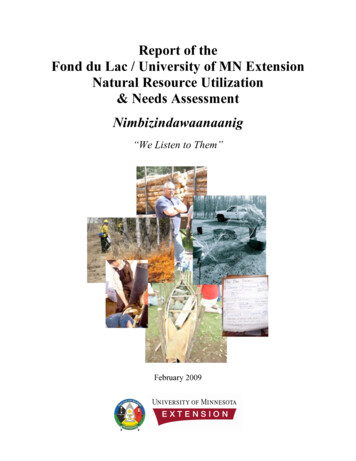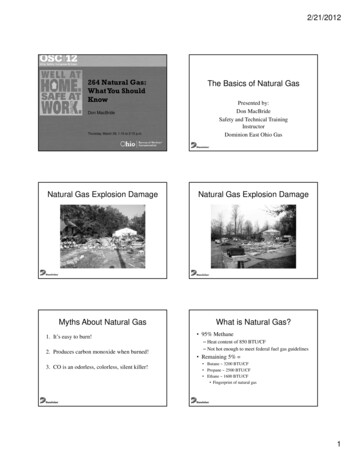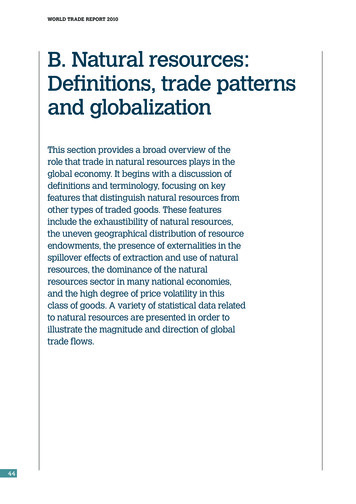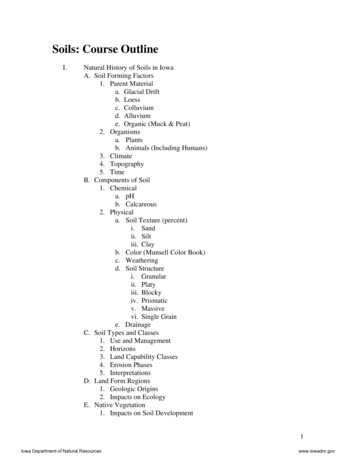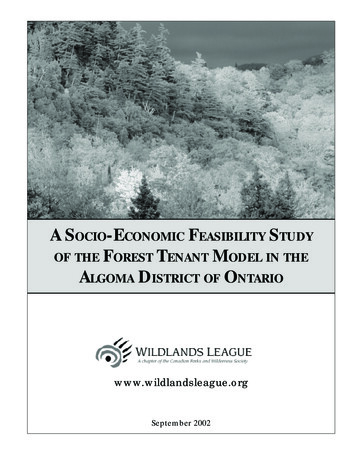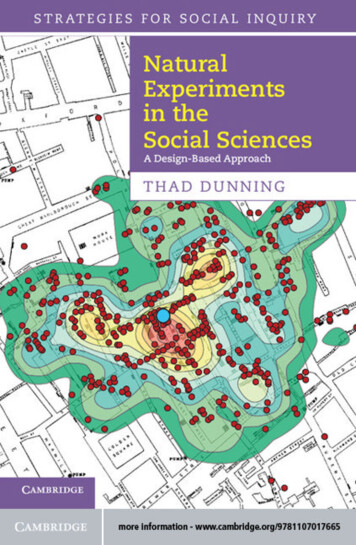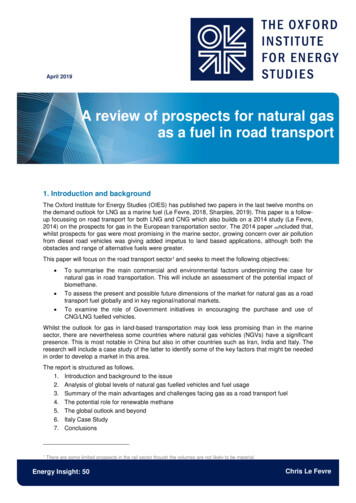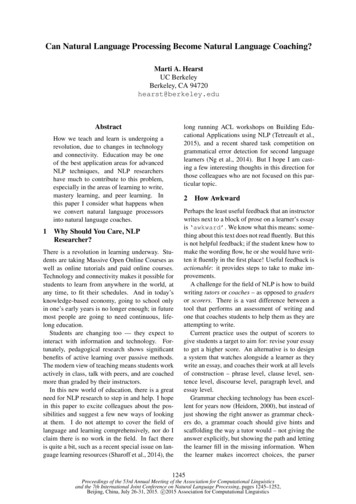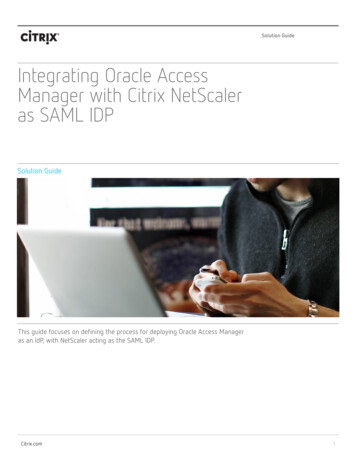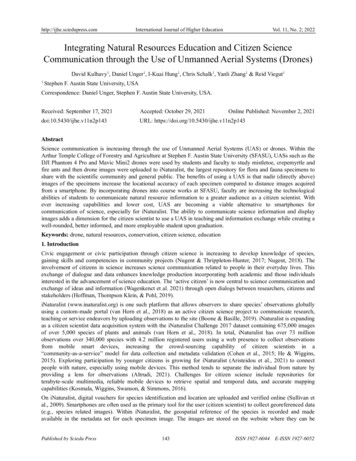
Transcription
http://ijhe.sciedupress.comInternational Journal of Higher EducationVol. 11, No. 2; 2022Integrating Natural Resources Education and Citizen ScienceCommunication through the Use of Unmanned Aerial Systems (Drones)David Kulhavy1, Daniel Unger1, I-Kuai Hung1, Chris Schalk1, Yanli Zhang1 & Reid Viegut11Stephen F. Austin State University, USACorrespondence: Daniel Unger, Stephen F. Austin State University, USA.Received: September 17, 2021Accepted: October 29, 2021Online Published: November 2, 2021doi:10.5430/ijhe.v11n2p143URL: nce communication is increasing through the use of Unmanned Aerial Systems (UAS) or drones. Within theArthur Temple College of Forestry and Agriculture at Stephen F. Austin State University (SFASU), UASs such as theDJI Phantom 4 Pro and Mavic Mini2 drones were used by students and faculty to study mistletoe, crepemyrtle andfire ants and then drone images were uploaded to iNaturalist, the largest repository for flora and fauna specimens toshare with the scientific community and general public. The benefits of using a UAS is that nadir (directly above)images of the specimens increase the locational accuracy of each specimen compared to distance images acquiredfrom a smartphone. By incorporating drones into course works at SFASU, faculty are increasing the technologicalabilities of students to communicate natural resource information to a greater audience as a citizen scientist. Withever increasing capabilities and lower cost, UAS are becoming a viable alternative to smartphones forcommunication of science, especially for iNaturalist. The ability to communicate science information and displayimages adds a dimension for the citizen scientist to use a UAS in teaching and information exchange while creating awell-rounded, better informed, and more employable student upon graduation.Keywords: drone, natural resources, conservation, citizen science, education1. IntroductionCivic engagement or civic participation through citizen science is increasing to develop knowledge of species,gaining skills and competencies in community projects (Nugent & Thrippleton-Hunter, 2017; Nugent, 2018). Theinvolvement of citizens in science increases science communication related to people in their everyday lives. Thisexchange of dialogue and data enhances knowledge production incorporating both academic and those individualsinterested in the advancement of science education. The ‘active citizen’ is now central to science communication andexchange of ideas and information (Wagenkenct et al. 2021) through open dialogs between researchers, citizens andstakeholders (Hoffman, Thompson Klein, & Pohl, 2019).iNaturalist (www.inaturalist.org) is one such platform that allows observers to share species’ observations globallyusing a custom-made portal (van Horn et al., 2018) as an active citizen science project to communicate research,teaching or service endeavors by uploading observations to the site (Boone & Basille, 2019). iNaturalist is expandingas a citizen scientist data acquisition system with the iNaturalist Challenge 2017 dataset containing 675,000 imagesof over 5,000 species of plants and animals (van Horn et al., 2018). In total, iNaturalist has over 73 millionobservations over 340,000 species with 4.2 million registered users using a web presence to collect observationsfrom mobile smart devices, increasing the crowd-sourcing capability of citizen scientists in a“community-as-a-service” model for data collection and metadata validation (Cohen et al., 2015; He & Wiggins,2015). Exploring participation by younger citizens is growing for iNaturalist (Aristeidou et al., 2021) to connectpeople with nature, especially using mobile devices. This method tends to separate the individual from nature byproviding a lens for observations (Altrudi, 2021). Challenges for citizen science include repositories forterabyte-scale multimedia, reliable mobile devices to retrieve spatial and temporal data, and accurate mappingcapabilities (Kosmala, Wiggins, Swanson, & Simmons, 2016).On iNaturalist, digital vouchers for species identification and location are uploaded and verified online (Sullivan etal., 2009). Smartphones are often used as the primary tool for the user (citizen scientist) to collect georeferenced data(e.g., species related images). Within iNaturalist, the geospatial reference of the species is recorded and madeavailable in the metadata set for each specimen image. The images are stored on the website where they can bePublished by Sciedu Press143ISSN 1927-6044E-ISSN 1927-6052
http://ijhe.sciedupress.comInternational Journal of Higher EducationVol. 11, No. 2; 2022verified by other community members (Teacher, Griffiths, Hodgson, & Inger, 2013).Mazumdar et al. (2018) documented emerging technologies for participation in citizen science for data collection,procession, visualization, and communication of ideas. One such emerging technology are Unmanned Aerial Systems(UASs) as the use of UASs is increasing in the conservation and management of natural resources (Evans et al., 2015)and can be used for science education and civic engagement such as iNaturalist. Pimm et al. (2015) promoted UASswith multispectral sensors, digital cameras and competitive costs using the iNaturalist model for crowdsourcing ofdata. For citizen scientists, many different UASs can be carried in a backpack, are relatively inexpensive, equippedwith a capable camera, and can be flown after suitable instruction for safety and hands-on training (Sattar, Tamatea,& Nawaz, 2017; Unger et al., 2019; Miller, Ziter, & Koontz, 2021).In teaching natural resources for science communication and applications to citizen science, the hands-on applicationof UASs employed by faculty at Stephen F. Austin State University (SFASU) motivates and engages studentspromoting active learning and knowledge creation while providing a learning environment for innovative solutions(Sattar, Tamatea, & Nawaz, 2017). For science education, UASs requires connecting multiple concepts from safety,mission planning, carrying out the mission, downloading data, data processing, then preparing the final productincluding maps and citizen science material for iNaturalist (Sattar, Tamatea, & Nawaz, 2017; Unger et al., 2019).Hands-on practice is essential to both motivate and engage students and is highly integrated into all course work atSFASU. As experience increases, confidence increases for the technical knowledge that leads to life and career skills.Continued use of UASs promotes problem solving and critical thinking skills to work with both geospatial scienceand technology information while using a UAS (Unger, Kulhavy, Busch-Petersen, & Hung, 2016; Sattar, Tamatea, &Nawaz, 2017). For these projects, students that completed the Mentored Undergraduate training (Unger, Kulhavy,Busch-Petersen, & Hung, 2016) including synthesis of data and uploading to iNaturalist were selected as drone pilotsand participants in the iNaturalist Drones and Biodiversity project.In addition to their suitability in applications for various projects, UASs possess a number of components that makethem ideal for integration into citizen science projects and educational endeavors, increasing their capabilitiestowards making observations on various subjects. In general, the components of an UAS include a GNSS (globalnavigation satellite system) receiver for positioning and airspeed of the aircraft; a camera for live view and takingimages; an inertial measurement unit for aircraft maneuver; a controller for both the flight and the camera; and aflight data recorder for UAS position and altitude parameters for each image (Hugenholtz, Moorman, Ridddell, &Whitehead, 2012; Whitehead & Hugenholtz, 2014). To highlight how studies between natural resource managementand citizen science can be integrated with the use of a UAS, we highlight the technology typically equipped in UASswhile also highlighting several case studies undertaken by students within the Arthur Temple College of Forestry andAgriculture at SFASU that demonstrate the potential integration with citizen science below.2. TechnologyAn UAS integrates a wide variety of technology into a user-friendly interface for operation. The advancement inmaterial technology allows for lighter and stronger aircraft while the battery continues to increase maximum flighttime. The improvement in sensor and GNSS technology equates to better control of the vehicle with greater precision,accuracy, and safety. The camera continues to pack more pixels into each frame, while the data transfer speed catchesup with the demand for larger data files. The controller interface, usually on a mobile device such as a smartphone ortablet, is as important as the aircraft itself, particularly in citizen science involving general public to take part in ascientific data collection endeavor. When internet services continue to expand while the price becomes moreaffordable and the transfer speed increases at the same time, ultimately everyone becomes part of the Internet ofThings (IoT).In our case studies, students under supervision by faculty employed different UASs with different technicalspecifications (Table 1) after completing extensive UAS training. Within them, the DJI Mavic Mini 2 is the only onethat can be operated when the environment temperature drops as low as -10 C (14 F), while the DJI Spark drone canbe controlled by hand gesture. Using each UAS to its highest potential is always our goal. Depending on therequirements of a project, the most appropriate UAS should be chosen. For example, for orthomosaic image and 3Dmodel creation, DJI Phantom 4 Pro is the one to use due to its higher image resolution and capable of operating in apre-planned flight mission. The Mavic Mini, flown using the app DJI Fly, with GPS GLONASS for positioning,weighs 249 g, just below the 250 g weight threshold that would require an FAA license in some areas is an excellentUAS candidate for educating students on the use of drones involved with citizen science communication andiNaturalist use.Published by Sciedu Press144ISSN 1927-6044E-ISSN 1927-6052
http://ijhe.sciedupress.comInternational Journal of Higher EducationVol. 11, No. 2; 2022Table 1. Technical specification comparison for UASsDJI Phantom 4 ProDJI SparkDJI Mavic MiniDJI Mavic Mini2AppDJI GO 4DJI GO 4DJI FlyDJI FlyFlight time (minutes)30163031battery6,000 mAh2,970 mAh2,600 mAh5,200 mAhCamera1” CMOS1/2.3” CMOS1/2.3” CMOS1/2.3” CMOS20 2-axis3-axis3-axisSpeed (kph, max)725046.857.6Range(fromcontroller, max)6,000 m2,000 m4,000 m10,000 mObstacle sensingforward, backward,TOF on both sidesforwarddownwarddownward29-38 kph20-28 kph28.8 kph29-38 kphGNSSGPS GLONASSGPS GLONASSGPS GLONASSGPS GLONASS GALILEOOperating temperature0 C - 40 C0 C - 40 C0 C - 40 C-10 C - 40 CMax service ceilingabove sea level6,000 m4,000N/AN/AWeight (g)1,388300249249Maxwindresistancespeed3. Case Studies3.1 MistletoeStudents used a DJI Phantom 4 Pro and a Phantom 4 version 2 UASs to document the presence and abundance ofparasite load of mistletoe plants on hardwood trees (Kulhavy et al., 2019). The UAS allowed the students to capturehigh quality images of both the mistletoe plants and host trees that we posted to a project entitled Mistletoes ofNacogdoches f-nacogdoches) on iNaturalist.org (Figure 1). Witheach image acquired using a UAS, the metadata (location, time, date) are automatically extracted and accompanyeach uploaded image (Figure 2).Published by Sciedu Press145ISSN 1927-6044E-ISSN 1927-6052
http://ijhe.sciedupress.comInternational Journal of Higher EducationVol. 11, No. 2; 2022Figure 1. Example of uploaded mistletoe imagery georeferenced to a spatial location within the iNaturalist onlineinterface (Lat: 31.58155, Lon: -94.658164)Figure 2. Example of mistletoe and host tree imagery uploaded to the iNaturalist.org website3.2 Crapemyrtle Bark ScaleTo assess crapemyrtle bark scale (Acanthococcus lagerstroemiae), a recently introduced pest in the United States,crapemyrtles (Lagerstroemia spp.) were located with drones by students and examined for the bark scale on theSFASU campus in Nacogdoches, Texas. The bark scale feeds on both leaves and stem of crapemyrtle with thenymphs producing secretions that result in high concentrations of sooty mold impairing photosynthesis and growthand well as turn the bark a distinctive, easily identifiable dark color (Wang et al., 2016; Layton, 2019). Acombination of a DJI Phantom 4 Pro using the app DJI Go 4 and the camera on a smartphone (for crapemyrtles closeto buildings) were used to record both the host tree and signs and symptoms of the bark scale (Figure 3).A total of 674 trees located by the UAS and 150 located by smartphone were assessed with 60 having bark scale.Following the UAS survey, 50 crapemyrtles infested with bark scale were removed by the university and replacedPublished by Sciedu Press146ISSN 1927-6044E-ISSN 1927-6052
http://ijhe.sciedupress.comInternational Journal of Higher EducationVol. 11, No. 2; 2022with spire oak. The record of both the host and the bark scale were entered into the Drones and BiodiversityiNaturalist project iodiversity). The image taken is 5,472 by 3,678pixels with the DJI Phantom 4 camera FC6310 (data extracted from the iNaturalist website) supplied with the UAS.Figure 3. Crapemyrtle infested with crapemyrtle bark scale. Image taken with a DJI Phantom 4 Pro UAS (Lat.:31.618233, Lon.: -94.648959)3.3 Red Imported Fire AntThe red imported fire ant (RIFA) (Solenopsis invicta) is an invasive species and was introduced in Texas in 1953with over 56 million acres (22.67 million hectares) now infested. Rationale for inventory of RIFA includes analyzingtheir distribution in city parks for control potential (Lard et al., 2002). Surveys for RIFA in pastures include fixed plotsize and walking transects to locate nest mounds (Steele et al., 2020). To investigate the feasibility of locating RIFAin city parks, a DJI Phantom 4 Pro was used by students to assess the overall park for RIFA mound locations (Figure4).Published by Sciedu Press147ISSN 1927-6044E-ISSN 1927-6052
http://ijhe.sciedupress.comInternational Journal of Higher EducationVol. 11, No. 2; 2022Figure 4. Initial DJI Phantom 4 Pro flight to detect nest mounds of the red imported fire antThis information was used to guide DJI Mavic Mini and DJI Mavic Mini 2 UASs (Figures 5 and 6) to furtherinvestigate potential RIFA locations. The UASs were flown by student drone pilots 3-4 m above the ground to takeimages of each nest mound (Figure 6). Images with latitude and longitude location data were entered into iNaturalistprojects Drones and Biodiversity, Fire Ants of East Texas, and Insects of Texas, provided a visual map of thelocations of the nest mounds, increasing the scope and availability of the iNaturalist data.4. ConclusionsWe highlight the method of using UASs student scientists to contribute data for iNaturalist and enhance scienceeducation to expand the collection ability for citizen scientists. Drones are an effective tool to bridge learning andexperimentation to communicate science (Sattar, Tamatea, & Nawaz, 2017). As UASs give accurate location at nadir(directly above the species located) when comparing with phone images which are generally taken at a distance, thisincreases the accuracy of the iNaturalist database. Students using UASs to communicate science with their projectshave a better understanding of natural resources and ecosystems. The training program implemented (Unger,Kulhavy, Busch-Petersen, & Hung, 2016) both enhanced the quality of the data, while leading to additional UASpilots passing the FAA Remote Pilot exam. UASs are able to expand collection of images of species not readilyavailable from ground-based smartphones or digital cameras, and also enables user to have a larger view of the studysite. The addition of the iNaturalist project Drones and Biodiversity formalized the capture of the data and expandedstudent use and citizen scientists uploading data for both teaching and research projects. For safety with UAS, theFAA implemented the Recreational UAS Safety Test (TRUST) for hobbyists and recreational pilots for aeronauticalsafety knowledge and rules for operating UAS (FAA, 2021). Data from the UASs were downloaded and uploaded tothe website either as single records or batch processed. The continued use of UASs will increase the accuracy of anyobservation and expand the data collection potential of observations on numerous citizen science databases,including iNaturalist. UASs are becoming increasingly integrated in scientific studies to increase the accuracy andprecision of identification and quantification of natural resources.Published by Sciedu Press148ISSN 1927-6044E-ISSN 1927-6052
http://ijhe.sciedupress.comInternational Journal of Higher EducationVol. 11, No. 2; 2022Figure 5. Location of a red imported fire ant (RIFA) nest mound using a DJI Phantom 4 Pro UAS, (Lat.: 31.56067,Lon.: -94.517122)Figure 6. Locating a fire ant mound using the DJI Mavic Mini UASFor natural resources, we present how UASs can expand the teaching and research base for investigating complexenvironmental, ecological and economic issues by using high end technology, working outdoors and making adifference in natural resource management training (Bullard et al., 2014). For student use of UASs for iNaturalist, afour-step process was implemented as part of mentored undergraduate research including UAS assembly andsafety/FAA (Federal Aviation Administration) rule training; performing a controlled flight to acquire both images andvideo as both a pilot in command and a visual observer; downloading UAS data into GIS (Geographic InformationSystem) software for quantitative analysis; and demonstrating use of the UAS acquired imagery in teaching andresearch. We encourage future citizen science participants and student led projects to explore the use of UASs andPublished by Sciedu Press149ISSN 1927-6044E-ISSN 1927-6052
http://ijhe.sciedupress.comInternational Journal of Higher EducationVol. 11, No. 2; 2022their continued integration into assessing and quantifying biodiversity for scienceAcknowledgementsThis project was completed using McIntire-Stennis funds administered by the Arthur Temple of Forestry andAgriculture, Stephen F. Austin State University.ReferencesAltrudi, S. (2021). Connecting to nature through tech? The case of the iNaturalist app. Convergence: TheInternational Journal of Research into New Media Technologies, 2021, 27(1), Aristeidou, M., Herodotou, C., Ballard, H. L., Young, A. N., Miller, A. E., Higgins, L., & Johnson, R. F. (2021)Exploring the participation of young citizen scientists in scientific research: The case of iNaturalist. PLoS ONE,16(1), e0245682. https://doi.org/10.1371/journal.pone.0245682Boone, M. E., & Basille, M. (2019). Using iNaturalist to contribute your nature observations to science. IFASExtension, University of Florida, WEC413, 5. https://doi.org/10.32473/edis-uw458-2019Bullard, S. H., Stephens Williams, P., Coble, T., Coble, D. W., Darville, R., & Rogers, L. (2014). Producing “societyready” foresters: A research-based process to revise the Bachelor of Science in Forestry curriculum at Stephen F.Austin State University. Journal of Forestry, 112, 354-360. https://doi.org/10.5849/jof.13-098Cohen, C., Cheney, L., Duong, K., Lea, B., & Unno, Z. P. (2015). Identifying opportunities in citizen science foracademic libraries. Issues Science Technology Librarians, 79, 1-13. doi: 10.5062/F4BR8Q66.Evans, I. J., Jones, T. H., Pang, K., Evans, M. N., Saimin, S., & Goossens, B. (2015). Use of drone technology as atool for behavioral research: a case study of crocodilian nesting. Herpetology Conservation Biology, 10(1),90-98. http://orca.cardiff.ac.uk/id/eprint/77762Federal Aviation Administration. (2021). The Recreational UAShttps://www.faa.gov/uas/recreational fliers/knowledge test updates/SafetyTest(TRUST).FAAHe, Y., & Wiggins, A. (2015). Community-as-a-Service: Data Validation in Citizen Science. 4th 2818048.2820063Hoffmann, S., Thompson Klein, J., & Pohl, C. (2019). Linking transdisciplinary research projects with science andpractice at large: introducing insights from knowledge utilization. Environmental Science & Policy, 102, Hugenholtz, C. H., Moorman, B. J., Riddell, K., & Whitehead, K. (2012). Small unmanned aircraft systems forremote sensing and earth science research. Eos, 93(25), 236-236. https://doi.org/10.1029/2012EO250005Kosmala, M., Wiggins, A., Swanson, A., & Simmons, B. (2016). Assessing data quality in citizen science. Frontiersin Ecology and the Environment, 14(10), 551-560. https://doi.org/10.1002/fee.1436Kulhavy, D. L., Schalk, C. M., Viegut, R. A., Unger, D. R., Shockley, S. W., & Hung, I. (2019). Using unmannedaircraft systems (UAS) to quantify mistletoe in urban environments. Urban Naturalist, 20, 1-10.Lard, C. L., Willis, D. B., Salin, V., & Robinson, S. (2002). Economic assessments of red imported fire ant on Texas’urban and agricultural sectors. Southwestern Entomologist (Supplement 25), 123-137.Layton, B. (2019). Crape myrtle bark scale identification and control. Mississippi State University ExtensionPublication 2938, 8.Mazumdar, S., Ceccaroni, L., Piera, J., Hölker, F., Berre, A., Arlinghaus, R., & Bowser, A. (2018) Citizen sciencetechnologies and new opportunities for participation. In: Hecker, S., Haklay, M., Bowser, A., Makuch, Z., Vogel,J. and Bonn, A. (eds.) Citizen Science - Innovation in Open Science, Society and Policy. (pp. 303-320). UCLPress: London. https://doi.org/10.2307/j.ctv550cf2.28Miller, J. E. D., Ziter, C. D., & Koontz, M. J. (2021). Fieldwork in landscape ecology. In: Francis, R. A., Millington,J. D. A., Perry, G. L.W. and Minor, E. S. The Rutledge Handbook of Landscape Ecology (pp. 219-229).Rutledge and Rutledge: NY. https://doi.org/10.4324/9780429399480-14Nugent, J. (2018). iNaturalist citizen science for 21st-century naturalists. Science Scope, 41(7), 12-13.https://doi.org/10.2505/4/ss18 041 07 12Published by Sciedu Press150ISSN 1927-6044E-ISSN 1927-6052
http://ijhe.sciedupress.comInternational Journal of Higher EducationVol. 11, No. 2; 2022Nugent, J., & Thripplehorn-Hunter, K. (2017). Experimental learning in the 21st century: Service learning and civicengagement opportunities in the science classroom. Science Education and Civic Engagement, 9(2), 40-46.Pimm, S. L., Alibhai, S., Bergl, R., Dehgan, A., Giri, C., Jewell, Z., Joppa, L., Kays, R., & Loarie, S. (2015).Emerging technologies to conserve biodiversity. Trends in Ecology and Evolution, 30(11), Sattar, F., Tamatea, L., & Nawaz, M. (2017). Droning the pedagogy: Future prospect of teaching and /1307-6892/10007926Steele, C. H., King, J. R., Boughton, E. H., & Jenkins, D. (2020). Distribution of the red imported fire ant Solenopsisinvicta (Hymenoptera: Formicidae) in Central Florida pastures. Environmental Entomology, 49, , B. L., Wood, C. L., Iliff, M. J., Bonney, R. E., Fink, D., & Kelling, S. (2009). eBird: A citizen-based birdobservation network in the biological sciences. Biological Conservation, 142(10), .006Teacher, A. G. F., Griffiths, D. J., Hodgson, D. J., & Inger, R. (2013). Smartphones in ecology and evolution: a guidefor the app-rehensive. Ecological Evolution, 3(16), 5268-5278. https://doi.org/10.1002/ece3.888Unger, D. R., Kulhavy, D. L., Busch-Petersen, K., & Hung, I. (2016). Integrating faculty led service learning trainingto quantify height of natural resources from a spatial science perspective. International Journal of HigherEducation, 5, 104-116. https://doi.org/10.5430/ijhe.v5n3p104Unger, D. R., Kulhavy, D. L., Hung, I., Zhang, Y., & Stephens Williams, P. (2019). Integrating drones into anatural-resource curriculum at Stephen F. Austin State University. Journal of Forestry, 117, 398-405.https://doi.org/10.1093/jofore/fvz031van Horn, G., Mac Aodha, O., Song, Y., Cui, Y., Sun, C., Shepard, A., Adam, H., Perona, P., & Belongie, S. (2018).The iNaturalist species classification and detection dataset. In IEEE/CVF Conference on Computer Vision andPattern Recognition. IEEE, Piscataway, NJ, 8769-8778. , K., Woods, T., Nold, C., Rüfenacht, S., Voigt-Heucke, S., Caplan, A., Hecker, S., & Vohland, K.(2021). A question of dialogue? Reflections on how citizen science can enhance communication betweenscience and society. JCOM, 20(03), A13. https://doi.org/10.22323/2.20030213Wang, Z., Chen, Y., Gu, M., Vafaie, E., Merchant, M., & Diaz, R. (2016). Crapemyrtle bark scale: A new threat forcrapemyrtles, a popular landscape plant in the U.S. Insects, 7(4), 78. https://doi.org/10.3390/insects7040078Whitehead, K., & Hugenholtz, C. H. (2014). Remote sensing of the environment with small unmanned aircraftsystems (UASs), part 1: a review of progress and challenges. Journal of Unmanned Vehicle Systems, 2(3) ghtsCopyright for this article is retained by the author(s), with first publication rights granted to the journal.This is an open-access article distributed under the terms and conditions of the Creative Commons Attribution /).Published by Sciedu Press151ISSN 1927-6044E-ISSN 1927-6052
from mobile smart devices, increasing the crowd-sourcing capability of citizen scientists in a "community-as-a-service" model for data collection and metadata validation (Cohen et al., 2015; He & Wiggins, 2015). Exploring participation by younger citizens is growing for iNaturalist (Aristeidou et al., 2021) to connect

